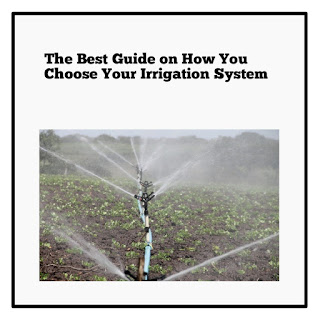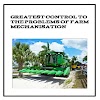Irrigation is the artificial application of water into the soil or land for farming purposes. Irrigation is the artificial supply of water to the land due to insufficient rain for that particular crop.
Water is the most important determinant in the growth of every plant.The choice of irrigation depends on the following:
(i) Availability of water
(ii) Slope of land
(iii) soil type
(iv) types of crops
(v) size of farmland
Aims of Irrigation
The aims of irrigation includes
1. To make early planting easy to practice
2. To add water to the soil in order to supply moisture for the growth of plants
3. To cool the soil temperature to make the land more favorable for plant growth
4. To ensure the survival of plants during dry season.
Importance of Irrigation on Crop Production
The effect of irrigation on crop production are:
1. Irrigation provide moisture in the soil for root absorption.
2. Irrigation makes the land to be soil for easy tillage operation.
3. It reduces the amount of salt accumulated in the top soil, which high salt in the soil could be harmful to crop plants.
4. Irrigation enables the crops to be well established even when rain is erratic.
5. It increases the productivity of crop or crop yield.
6. It helps to reduce the soil temperature during hot season when the soil temperature is very high which could be harmful to plant and hence,it improves the yield of plants.
8. Irrigation will help to dissolve the nutrients in the soil for the to absorb it better.
9. It helps to make a crops to be planted many times a year depending on the crop.
10. Irrigation improves the microbial decomposition of organic manure to help release nutrients the soil.
Irrigation System
Irrigation system or types can be grouped into three main classes. These are :
1. Surface Irrigation
2. Sub-surface irrigation
3. Overhead irrigation
Surface Irrigation
In this system, water from rivers,dams or stream flows along the surface of the farmland. This can be in form of flooding,furrow, basin, border ditch etc. The most most important conditions for surface irrigation to be efficient is for the land to have a very great slope so that the water will flood over it successfully.
Advantages of Surface Irrigation
1. This system of irrigation is easy to construct.
2. It prevents the soil from the accumulation of alkalis.
3. Surface irrigation is cheap to establish and main.
4. It helps to remove excess water caused by heavy rainfall especially in heavy soils.
5. It increases the activities of microbes in top soil.
Disadvantages of Surface Irrigation
1. Some crops may not tolerate heavy flooding
2. This system cannot be successful in sandy soil.
3. The volume of the water may be too high sometimes and may difficult to control.
4. It cannot be practised where the land is hilly.
Factors to be considered in choosing surface irrigation method.
1. The soil type because it's not successful in sandy soil.
2. The size of farmland
3. The type of crop that is grown
4. The topography or sloppy land.
Sub-surface irrigation - In this system of irrigation, the water is applied below the soil surface by using artificial water level at certain depth. This system depends on type of crops to be grown and the nature of soil. Perforated pipes are used to apply water within the soil, and the water gets to the roots of the crops through capillary action.
Advantages of Sub-surface irrigation
1. It also promotes low evaporation losses from soils.
2. In addition, water use efficiency is very high.
3. This system doesn't create any obstruction or obstacles when carrying out cultural practices.
Disadvantages of Sub-surface irrigation
1. This system requires some expertise which is not available
2. Water with high salt content cannot be used.
3. This system is a bit expensive.
Factors to be considered in choosing sub-surface irrigation method
1. Soil structure
2. The level of water table.
3. Soil texture or capillarity
4. The permeability of sub stratum.
Overhead Irrigation
In this system of irrigation, water is supplied to the farm land above the surface of soil. Overhead irrigation exist in two forms:
Sprinkler Irrigation and Drip Irrigation
(a) Sprinkler Irrigation: In this system of irrigation, water is sprayed from the air and it's allowed to fall on the ground surface somehow as rainfall, through nozzles under high pressure. Pumping machine that operates under high pressure is needed to pump water into irrigation pipes which are spaced to ensure that water reaches everywhere.
Advantages of Sprinkler Irrigation
(i) The amount of water supplied can be regulated.
(ii) It economises the use of water.
(iii) It can be used for all crop except tree crops like Cocoa, mango etc
(iv) Fertilizers that are soluble can be mixed with the water and applied through irrigation.
Disadvantages of Sprinkler Irrigation
(i) Sprinkler irrigation can be too cost to operate.
(ii) A stable water supply is required
(iii) High wind may prevent even distribution of the water.
(iv) There is lack of technical know-how which is needed.
(b) Drip Irrigation: Drip irrigation is the new method where the water is supplied through nozzles called drippers or emitters at selected spacing to deliver water to the soil surface near the base of the plant.
Advantages of Drip Irrigation
(i) It is economical in the use of water
(ii) It reduces salt concentration in the root zone .
(iii) Fertilizers can be applied through this system.
Disadvantages of Drip Irrigation
(i) This method is very expensive to maintain and set up.
(ii) Hard water cannot be used.
Problems associated with irrigations
1. Irrigation equipment is very expensive.
2. It may less to pollution, if it contains dangerous chemicals.
3. Irrigation is very expensive to maintain
4. Diseases causing organisms increase with increasing humidity.
5. Pests from dry surroundings may invades and damage crops in irrigated land.
6. Inadequate water supply for irrigation.
How to reduce diseases build up in Irrigation
(i) Crop Rotation
(ii) Use of clean tools
(iii) Weed Control
(iv) Use of clean planting materials
(v) Use of appropriate chemicals.
Methods of Irrigating a small Nursery
1. Drip Irrigation
2. Use of watering can
3. Manual Sprinkling e.g hand,brooms, brush
4. Channel Irrigation
Source of Water For Irrigation
1. Rivers
2. Streams
3. Dams
4. Boreholes
5. Wells
6. Lakes and Reservoir







0 Comments